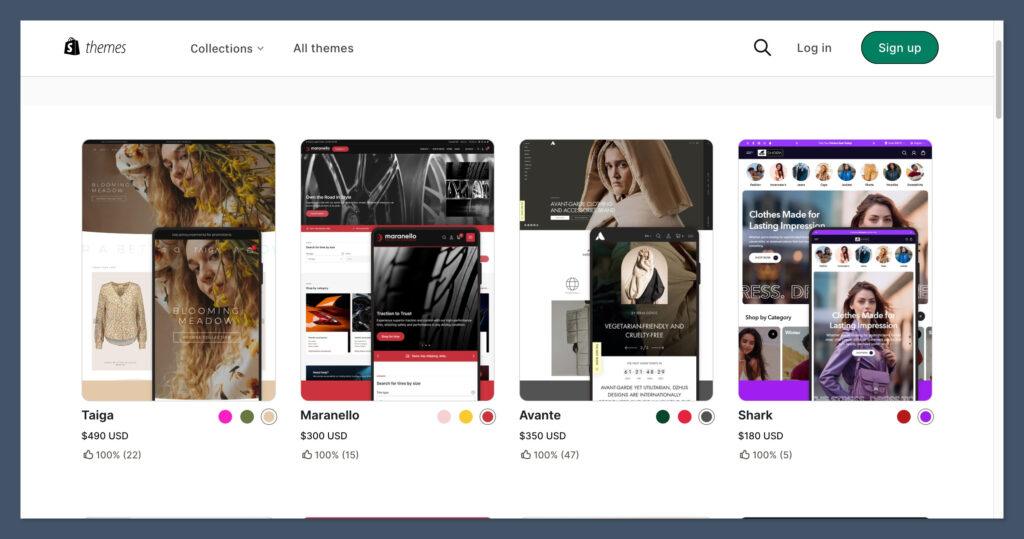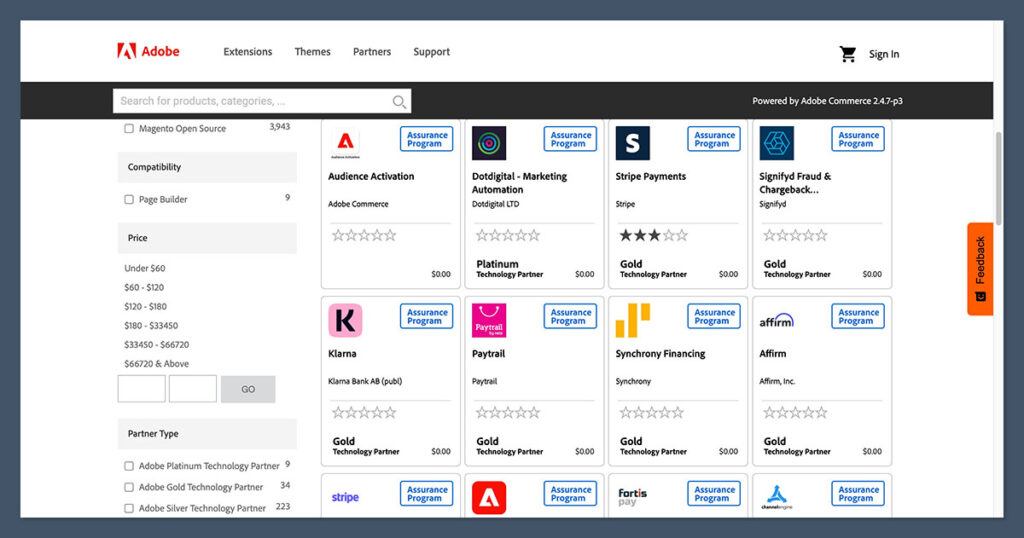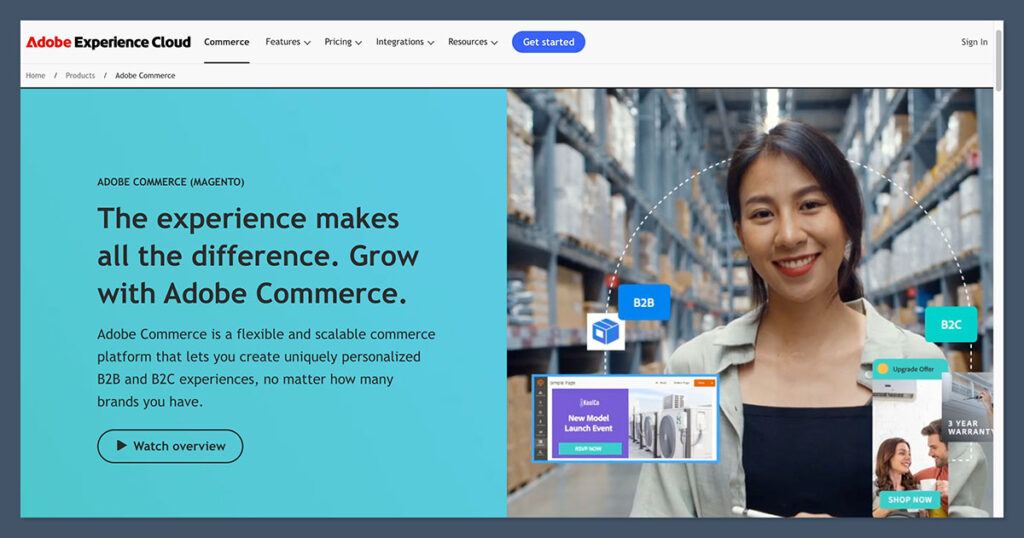If you’re planning on launching an ecommerce store, you’ve probably heard of Shopify, and Adobe Commerce (formerly Magento). Both of these tools have an excellent reputation among online merchants, and I consider both to be powerful tools in their own right.
So, which should you choose?
Personally, I’d always recommend Shopify is the go-to choice over Adobe Commerce. It’s a flexible, easy-to-use, and low maintenance solution with exceptional scalability.
Adobe Commerce has some great sales features, and limitless customization options, but it’s a lot tougher to use for beginners (and it can be more expensive too).
Here’s my head-to-head comparison of both platforms, based on genuine hands-on experience, to help you make the right choice for your company.
Quick Verdict Pros and Cons
If you want a quick answer to whether you should use Shopify or Adobe Commerce for your online store, I’d say Shopify will be the better pick for 99% of merchants.
It’s a far more intuitive, budget-friendly, and flexible platform overall. Plus, it still gives you access to tons of advanced features, like omnichannel commerce, AI-powered tools, and even a built-in POS system.
Adobe Commerce has its benefits, but I’d really only recommend it to large enterprise companies looking for extensive customization options.
Shopify Pros and Cons
Pros
- Incredibly easy to use
- Great themes and design tools
- Tons of impressive sales features on every plan
- Support for thousands of integrations
- Powerful AI tools built-in
- Advanced omnichannel sales support
- Flexible payment processing
Cons
- Transaction fees for third-party gateways
- Some limitations on website design
- Slightly expensive pricing for small businesses (to start with)
Adobe Commerce Pros and Cons
Pros
- Limitless design customization options
- AI tools for generating promotional offers
- Seamless scalability for any sized business
- Excellent reporting and analytics tools
- B2B and B2C selling options
- Support for various payment methods
Cons
- Steep learning curve for beginners
- Expensive pricing
- Relies heavily on third-party apps
Shopify vs Adobe Commerce: Expert Comparison

Both Shopify and Adobe Commerce are platforms that help businesses launch a website, and start selling products online. However, they are more different than you might think.
Shopify is an all-in-one SaaS solution that combines everything you need into a single package.
It’s designed to make launching your online store as easy as possible.
Alternatively, Adobe Commerce is a more complex option. It’s built on an open-source platform, and does offer a lot more flexibility, particularly when it comes to web design, but it’s not intended for true beginners.
Adobe Commerce basically gives you the “foundations” of your store, and then you need to add and implement everything else yourself (or by purchasing additional services).
Let’s take a closer look at these platforms side-by-side.
Website Design and Development
First, I want to point out that Shopify is one of my favorite tools for building ecommerce websites, simply because it makes the process so simple.
You get access to hundreds of themes you can choose from for your store (although some of them cost extra).

Plus, you can customize your store in a range of different ways with the straightforward “Theme Editor”.
You really don’t need any coding knowledge or expertise to make your store look great with Shopify, but you can dive into CSS and JavaScript if you want to.
The only real downside is that the section-based editor can feel a little restrictive at times.
It’s hard to deny that Adobe Commerce is more flexible from a design perspective.
You don’t really get a lot of templates, but you do get a handy page builder app, with drag and drop tools that can help you to build great shopping experiences without extensive developer knowledge.
However, you will need a bit of technical expertise if you want to take full advantage of everything Adobe Commerce has to offer.
It takes a lot of work to actually configure everything to suit your needs. The good news is you can build more than just websites with Adobe Commerce.
You get a flexible architecture you can use to design adds, and headless experiences too.
However, once again, you’re going to need a lot of skill, or the support of a professional web designer and developer to make the most of this functionality.
Ecommerce and Sales Features
It’s always hard to find anything to fault about Shopify’s ecommerce and sales features. You really do get everything you need to run a successful store in one package. Shopify has its own world-class checkout and payment processing service (or you can connect your own).
It even supports a built-in point of sale solution, and enables integrations with marketplaces and social media platforms for omnichannel sales.
You can process just about any kind of payment with Shopify, and sell any product you can imagine, including subscriptions and digital products (with apps).
Plus, Shopify offers services and tools to help you with shipping and fulfillment too.
You can connect your store to POD and dropshipping platforms, or use Shopify’s own Fulfillment Network.
Notably, both Shopify and Adobe Commerce also support both B2B and B2C selling – although you’ll need a Shopify Plus plan for B2B sales on that platform.
Adobe also supports multi-channel ecommerce, with a channel manager system for processing sales through your store, marketplaces, and other environments. There’s no integrated POS solution, but you can add one through Adobe extensions.

Beyond that, you can sell any type of product with Adobe Commerce, accept virtually any payment method, and even tailor the shopping experience to each individual customer with AI.
However, you will need to install apps to use payment processors like Stripe or Square. Plus, you’ll struggle to align all of your channels initially with this platform if you don’t have developer knowledge.
Marketing and Customer Experience
Neither Shopify nor Adobe Commerce particularly excel in terms of in-built marketing solutions. They both allow you to create blogs for your website for content marketing, and integrate with social media channels or email marketing systems.
They’re also both relatively SEO-friendly platforms, so you shouldn’t have to worry too much about making sure your store can rank on result pages.
Shopify does have some more advanced features built-in for marketing, like abandoned cart recovery tools, and its own email system. However, where both companies really excel is in designing exceptional experiences for customers.
Shopify allows companies on certain plans to create dedicated versions of their stores for different markets, and the built-in AI tools, like Shopify Magic, are great for creating personalized FAQs, product descriptions, advertising campaigns and more.
You can even use AI to turn live chats into checkouts with Shopify.
Adobe also performs admirably in this area, giving you access to integrated AI solutions that you can use to create and optimize content, and deliver relevant promotions to customers in real-time. You can even use AI for personalized site search and product recommendation experiences.
Reporting, Analytics and Integrations
Getting deep insights into your business and its performance is crucial for success, but it can often be challenging without the right platform. Shopify and Adobe Commerce don’t struggle in this area.
Shopify offers access to daily sales reports packed with data on product, sales, and staff performance. You can also create cash flow reports, retail sales reports, and finance reports.
Plus, Shopify integrates with a huge range of applications you can use to unify data insights about customer experiences, and profits.
Adobe also has a fantastic range of analytical and reporting tools built-in, including a full system for creating custom dashboards and visualizations.
However, Adobe doesn’t integrate with quite as many analytical tools as Shopify. In fact, Adobe’s integration options are more limited overall.
Shopify gives you thousands of tools you can connect to your store, whereas Adobe Commerce only offers a handful of options. It does, however, offer excellent integrations with Adobe products, like Adobe Experience Manager.
Shopify vs Adobe Commerce: Pricing Plans

I mentioned above that Shopify can be a little expensive for some small businesses to begin with, but it’s still a much cheaper option than Adobe Commerce.
Shopify’s pricing plans range from $29 to $299 per month for the core plans (paid annually) after a free 3 day trial. There’s also an Enterprise plan available with packages starting at $2,300 per month.
Plus, if you just want to sell products through social media platforms, there’s the Starter Plan for $5 per month.
One slight downside with Shopify’s pricing is that you do need to pay extra transaction fees if you’re using third-party payment processors, but you can sidestep those with Shopify Payments.
Adobe Commerce’s pricing is a little more complex. There are two packages you can choose from: Adobe Commerce Pro, and Managed Services.
With both options, you need to contact Adobe Commerce for a quote based on your specific needs. Plus, there are likely to be additional costs to consider, since you’re using an open-source platform.
This means you’ll need to factor in the cost of web hosting, domain names, extensions, and probably extra support with web design and development too.
Shopify vs Adobe Commerce: The Verdict
So, which platform should you choose? Both of these options have their benefits.
Adobe is great for flexibility and customization, making it a good choice for enterprise-level companies with unique requirements. However, it’s incredibly complex to use, and can be very expensive too.
Overall, Shopify is the better solution for most companies, because it’s wonderfully easy to use, flexible, and reasonably affordable.
It can support most of the same capabilities of Adobe Commerce, without the technical headaches and extra expenses.
Unless you have a lot of developer knowledge and a huge budget, I’d recommend choosing Shopify every time.



